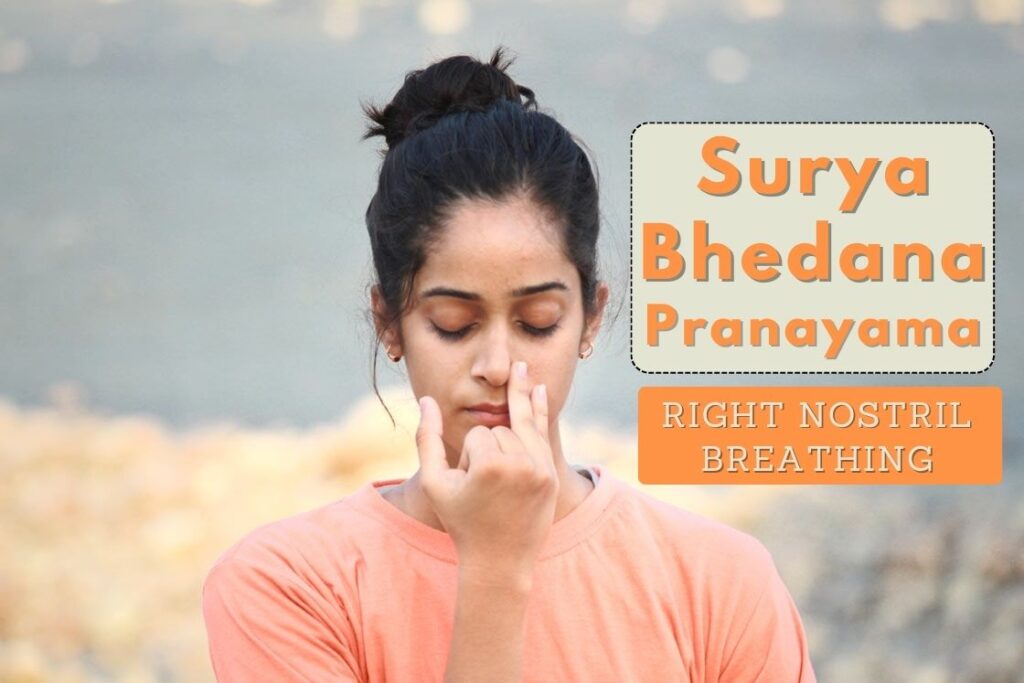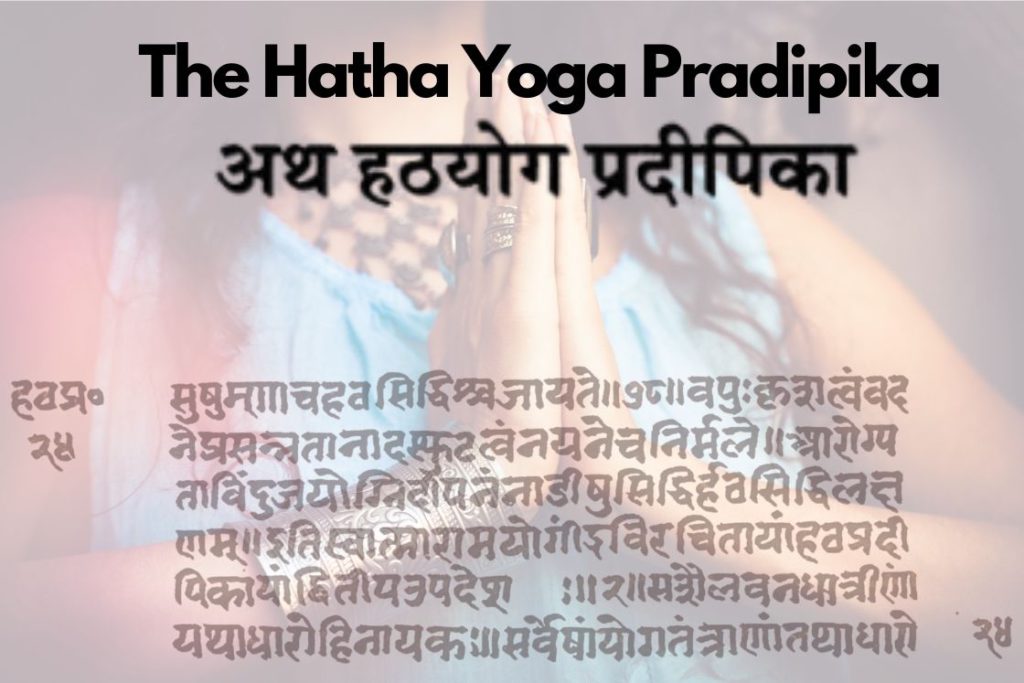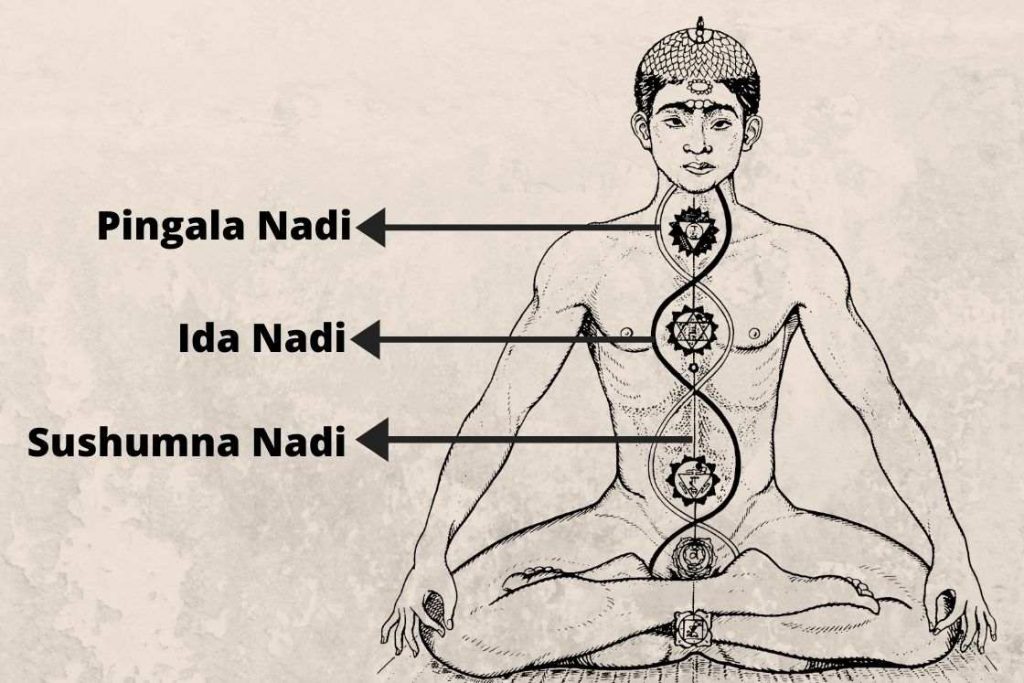
Surya Bhedana Pranayama, also known as Sun-Piercing Breath, is a powerful yogic breathing technique that awakens the body’s inner energy and sharpens mental clarity. More than just a breathing method, it’s a tool to boost vitality, warmth, and focus.
This practice involves inhaling through the right nostril and exhaling through the left stimulating the Pingala Nadi, or solar energy channel. As a result, it increases internal heat, improves alertness, and energises the entire system.
Unlike normal breathing, Surya Bhedana follows a specific nostril-based rhythm that enhances breath control and balances the body’s energy flow.
In this guide, you’ll learn what Surya Bhedana Pranayama is, its benefits, and how to practise it step by step with proper technique.
Understanding the meaning of surya bhedana pranayama
Surya Bhedana Pranayama is a classical yogic breathing technique, with its name derived from Sanskrit. The term consists of three words: Surya (sun), Bhedana (piercing or passing through), and Pranayama (breath control). Together, the phrase refers to a breathing practice that directs the sun’s energy through the right side of the body.
Some yogic texts also refer to this technique as Surya Bhedi Pranayama, though both names describe the same practice.
The defining feature of Surya Bhedana is inhalation through the right nostril, which is connected to the Pingala Nadi the solar energy channel in yogic physiology. This nadi is linked with heat, vitality, and active energy. Activating it through controlled breathing is believed to increase alertness, body warmth, and dynamic energy.
In English, Surya Bhedana Pranayama is sometimes called Right Nostril Breathing or Sun Piercing Breath, reflecting both the technique used and its energising effect.
The name and method of this practice reflect the yogic understanding of how breath influences energy flow in the body, especially the connection between the breath, the nadis, and natural elements like the sun, which symbolises vitality and life force.
Surya bhedana pranayama in hatha yoga

Surya Bhedana Pranayama holds a respected place in traditional yogic teachings, especially in authoritative texts like the Hatha Yoga Pradipika. This classical manual, attributed to the sage Swatmarama, identifies Surya Bhedana as one of the eight classical pranayamas, also referred to as Kumbhakas, highlighting its significance in the system of Hatha Yoga.
The Hatha Yoga Pradipika explores the deeper effects of this practice. In verse 2.50, the text states:
“Surya Bhedana is an excellent pranayama that destroys disorders caused by excess wind, purifies the brain, and cures diseases caused by worms.”
This verse illustrates the cleansing and therapeutic nature of the practice. Surya Bhedana is described not only as a method for balancing vata dosha (wind-related imbalances) but also for improving mental clarity and eliminating internal impurities, supporting both physical and energetic health.
The science of nadis in surya bhedana pranayama

In yogic science, the concept of Nadis is fundamental especially in practices like Surya Bhedana Pranayama. The term Nadi, derived from Sanskrit, means “channel” or “flow,” referring to the subtle pathways through which pranic energy (life force) moves throughout the body.
Among the many nadis, two hold central importance: Pingala and Ida. These correspond to the right and left nostrils, respectively, and reflect the dual forces of energy and calmness.
Pingala Nadi, connected to the right nostril, is often called the Surya (Sun) Nadi. It represents the qualities of activity, heat, and outward expression, governed by Rajas Guna. In contrast, Ida Nadi, linked to the left nostril, is known as the Chandra (Moon) Nadi, associated with coolness, introspection, and calming energies.
Surya Bhedana Pranayama primarily activates Pingala Nadi. Through intentional inhalation via the right nostril, this practice stimulates the sympathetic nervous system, enhancing alertness, vitality, and dynamic energy. It is more than a breathing exercise it is a subtle method of directing prana through specific energy channels to influence both body and mind.
Also read: Difference between Surya Bhedana and Chandra Bhedana Pranayama
How to do surya bhedana pranayama(steps)

The technique: Adopt a comfortable seated posture and form Vishnu Mudra with your right hand for Surya Bhedana Pranayama. Begin by blocking the left nostril, inhaling deeply through the right. Then, close the right nostril and exhale slowly through the left. Maintain this pattern – inhale through the right, exhale through the left – for a duration of 1 to 3 minutes, ensuring smooth and controlled breaths.
Here’s detailed steps to perform it:
step 1
Preparation: Begin by finding a comfortable seated position. Easy Pose (Sukhasana) is recommended for beginners, while advanced practitioners may opt for Lotus Pose (Padmasana). Ensure your spine is erect and your body relaxed.
step 2

Adopt Vishnu Mudra with right hand: Position the mudra near your face, using your ring finger to close the left nostril. Your thumb stays close to right nostril but not blocking it. Before initiating the breathing process, ensure your lungs are fully emptied by exhaling deeply.
step 3

Inhale Through the Right Nostril: Use your ring finger to gently close the left nostril. Inhale deeply and smoothly through the right nostril, filling your lungs with air.
step 4

Retain the Breath: After inhaling, use your thumb to softly close the right nostril, holding the breath for a comfortable duration. Avoid strain, especially if you are new to pranayama or have health concerns.
step 5

Exhale Through the Left Nostril: Release your ring finger from the left nostril and exhale slowly and completely.
As you exhale through the left nostril, notice the warmth of the air. This sensation is a testament to the internal heat generated by the Surya Bhedana Pranayama, reflecting the practice’s energizing effect on the body.
step 6
Repeat the Cycle: Continue this pattern for several rounds, following a rhythm that feels natural and comfortable to you.
Beginners may find it helpful to start surya bhedana pranayama with shorter sessions of 1 to 3 minutes or 3 to 6 rounds. Then gradually increase the duration upto 10 minutes as you become more comfortable with the technique. Remember, the essence of pranayama lies in gentle progression and attentive practice.
Breathing technique and ratios in surya bhedana pranayama
A single cycle of Surya Bhedana Pranayama encompasses three key steps: inhaling through the right nostril (Step 3), retaining the breath (Step 4), and exhaling through the left nostril (Step 5).
To practice effectively, follow this sequence: inhale through the right nostril, hold the breath momentarily, and then exhale through the left nostril. Continue this pattern for a duration of 1-3 minutes or complete 5-10 cycles.
The breath ratio in Surya Bhedana Pranayama varies based on proficiency. Beginners may initially forego the breath retention (Step 4), maintaining a 1:1 ratio for inhalation and exhalation.
For more experienced practitioners, an advanced ratio of Inhale: Hold: Exhale is recommended at 1:4:2. This means if you inhale for one second, retain the breath for four seconds, and exhale over two seconds. This advanced ratio should be attempted only after at least 15 days of consistent practice.
Benefits of Surya bhedana pranayama
Surya Bhedana Pranayama is a powerful yogic breathing technique known for its energising and warming effects. It stimulates the body’s solar energy channel (Pingala Nadi), supports physical health, sharpens mental focus, and contributes to spiritual growth. Below are the key benefits explained in simple terms:
Surya Bhedana Pranayama benefits include improved energy, better heart and digestive health, sinus relief, mental clarity, and even spiritual awakening.
- Enhances Physical Performance: This pranayama boosts physical energy and stamina by increasing internal heat and oxygen supply. It supports those with active routines and helps improve endurance in daily life or exercise.
- Improves Cardiovascular Health: Surya Bhedana supports heart health by improving circulation and oxygenation. With regular practice, it may assist in maintaining healthy blood pressure and heart function.
- Activates Sympathetic System: Breathing through the right nostril stimulates the sympathetic nervous system, which increases alertness, responsiveness, and readiness for action. It helps in building energy during times of fatigue or low motivation.
- Clears Sinuses: The warming nature of this pranayama helps open and cleanse the nasal passages. It’s particularly useful in relieving nasal congestion during cold or allergy seasons.
- Aids Weight Loss: By boosting metabolism and internal heat, Surya Bhedana may support healthy weight loss when combined with proper diet and physical activity. It encourages a more active and energetic lifestyle.
- Balances Vata Dosha: According to Ayurveda, this pranayama helps pacify excess Vata, which is linked to dryness, coldness, and restlessness. It brings grounding and warmth to the body and mind.
- Awakens Kundalini Energy: In yogic traditions, Surya Bhedana is believed to awaken dormant Kundalini energy when practised with mudras and bandhas. This supports deeper spiritual awareness and inner transformation.
- Supports Digestive Health: This practice stimulates Jatharagni (digestive fire), aiding digestion and relieving issues like bloating, gas, and sluggish metabolism. It promotes a healthier and more efficient digestive system.
- Purifies Blood and Detoxifies Body: Regular practice increases circulation and may support blood purification by enhancing oxygen flow and removing toxins from the body through breath.
- Improves Mental Clarity and Alertness: Surya Bhedana sharpens focus, boosts concentration, and clears mental fog. It prepares the mind for tasks that require attention and supports a meditative state.
Precautions and contraindications
Although Surya Bhedana Pranayama is beneficial, it should be practised mindfully. The following precautions help ensure safe and effective practice:
- Avoid Overstraining: Do not hold your breath for too long, especially if you’re new to pranayama. Start slowly and increase duration only as your comfort and control improve.
- Medical Conditions: People with heart problems, high blood pressure, epilepsy, or those recovering from major surgery should avoid this practice unless advised by a qualified yoga therapist or doctor.
- Acid Reflux and Digestive Issues: If you suffer from acid reflux, indigestion, or loose motions, this heating pranayama may worsen symptoms. Practise only under expert guidance in such cases.
- Avoid During Illness: Avoid practicing Surya Bhedana when you have a fever, cold, or any acute illness. Let your body rest and recover fully first.
- Avoid in Hot Weather: As this pranayama increases body heat, it’s best not to practise it in hot, humid weather or after sun exposure. Choose a cool, ventilated place and practice during cooler parts of the day.
- Pregnancy Considerations: Pregnant women should not practise Surya Bhedana, especially in the second and third trimesters, as the heat and breath retention may not be safe.
- Menstruation: Women should avoid this practice during their menstrual cycle, as the heat and internal pressure may cause discomfort or imbalance.
People with heart conditions, high blood pressure, or digestive issues should avoid Surya Bhedana Pranayama. It’s also not suitable during pregnancy, menstruation, or illness.
Conclusion
Surya Bhedana Pranayama is a powerful yogic breathing technique representing the Ha energy in Hatha Yoga, which symbolizes the Sun and warmth. By inhaling through the right nostril and exhaling through the left, this practice balances opposing energies like heat and coolness, joy and calm, creating harmony within the body and mind.
Regular practice improves breath control, emotional balance, and mental clarity, bringing a deep sense of peace and happiness. It is also believed to slow the ageing process. With its many benefits, including Surya Bhedana Pranayama in your daily routine can enhance your overall well-being and help you live a more balanced and healthier life.
FAQs Related to Surya Bhedana Pranayama
The ideal time to practice is in the early morning on an empty stomach. It can be practiced anytime, following pranayama guidelines, but should be avoided in summer, during the hottest part of the day, and after sunset.
It is contraindicated for individuals with epilepsy, heart disease, anxiety, and high blood pressure. It should be avoided at night to prevent difficulty in falling asleep, and consultation with a yoga instructor and physician is recommended before starting a new practice, especially for those with chronic health conditions.
Surya Bhedana is generally safe when performed correctly and with awareness of contraindications. The challenging part is retaining the breath, which should not be pushed beyond natural limits. If dizziness or fainting occurs, stop the practice and breathe normally while lying down in Corpse Pose.





This is a great article, gives precious knowledge
Hi Ashish,
Surya bhedana your explanation about this pranayama is excellent. Very clear, simple , step by step instructions
makes it very easy to follow and encourage practice..
Thanks
Waiting for more.
Regards
Karun